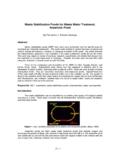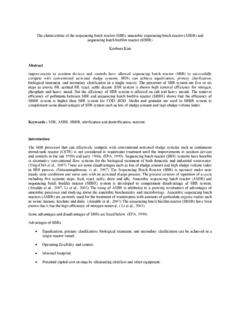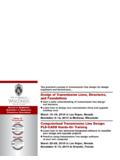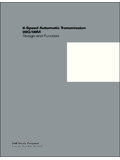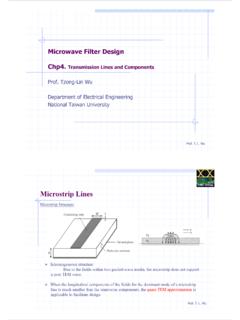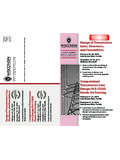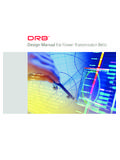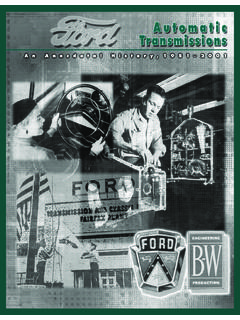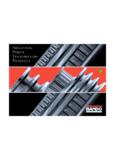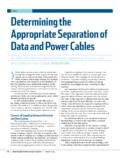Transcription of UTransmission Line Loading - Iowa State University
1 IOWA State University . Transmission line Loading Sag Calculations and High-Temperature Conductor Technologies James Slegers 10/18/2011. Transmission line Loading 1. Contents Introduction 2. 1. Sag Calculation 2. a. Thermal Elongation 5. b. Stress-Strain Behavior 5. c. Sag at High Temperature 6. d. Sag with Ice Loading 7. e. Behavior of Layered Cables 8. 2. Ampacity of a Conductor 10. a. Heat Balance Equation 11. b. Radiant Heat Loss 11. c. Convective Heat Loss 11. d. Solar Radiation 12. e. AC Losses 12. f. Ampacity of the Conductor 12. 3. High Temperature, Low Sag Transmission Technologies 14. a. Conventional Conductors (AAC, AAAC, ACSR) 14. b. Aluminum Conductor, Steel Supported (ACSS) 15. c. (Super) Thermal-Resistant Aluminum Alloys ((Z)TACSR and (Z)TACIR) 16. d. Composite Cores (ACCC, ACCR) 16. e. Invar Core (TACIR) 17. f. Gap-Type Conductors (G(Z)TACSR) 18. 4. Comparison of High Temperature Conductors 18. A. Material and Electrical Properties of Conductor Cables 24.
2 Transmission line Loading 2. Introduction Transmission lines are physical structures, installed in the natural environment an environment which subjects them to wind, rain, ice, snow, sunlight, and pollution. Beyond the natural environment, these structures exist in a human-developed environment. Structures must be designed to minimize damage to themselves, as well as preventing injury to humans and other structures. A successful design will be safe, reliable, and efficient. A few specific design criteria will be described below, which contribute to such a design. Transmission lines will be designed to limit the distance that their conductors will sag, so that a minimum vertical clearance is maintained between the cables and the ground. This clearance must be guaranteed for a maximum static load. Guidelines for establishing a maximum static load are outlined by the National Electrical Safety Council (NESC) in the US and the International Electrotechnical Commission (IEC) throughout the world, and generally define this load in terms of the amount of ice accumulation that is likely to occur on a given line .
3 Another form of static Loading is wind displacement, where a steady wind will act on a conductor. Ice accumulation and high winds both occur during the same part of the year, so lines must be rated to withstand both phenomena simultaneously. The NESC and IEC also provide specifications for the distances between individual conductors. Uncontrolled conductors which sway in strong winds may pass close to each other, causing arcing and short-circuit behavior. This is unacceptable. Many strategies are used to prevent this from occurring. Vortex shedding by some cables can cause Aeolian vibration, a constant hum of the cable. This vibration causes significant conductor motion, and can shorten the lifespan of the cable and the support structures due to fatigue. Aeolian vibration is only significant for transmission lines built in a very specific scale of geometry, such that the frequency of vortex shedding behavior closely matches their natural frequency of vibration.
4 It can be mitigated by adding conductor spacers, which change the natural frequency of the conductor. Vibration can also be mitigated by using unique conductors which dissipate mechanical energy or through conductors of unique geometries which spread the vortex-shedding behavior over a range of frequencies. In general, longer and heavier cables will be more resistant to vibration. Ice shedding is a common event for lines which accumulate ice. When ice falls off of a conductor, it often comes off in large quantities. This sudden change in Loading will cause the conductor to jump.' This displacement is mostly vertical, rather than horizontal. This phenomena will be analyzed for lines that may accumulate ice, to show that in the event of ice-shedding, phase conductors will not be brought close enough to induce arcing. This is typically remedied by increasing the vertical spacing between conductors. In some circumstances, terrain, weather, and wind may come together to produce galloping.
5 '. Galloping is a violent motion of conductors which may cause displacements of cables by up to 10 feet in long spans. The displacement of galloping will typically be restricted to an elliptical zone around the static position of the line . Like Aeolian vibration, it may be reduced by adding phase-spacers. Slackening conductors may also reduce this behavior. Generally, thicker (and thus heavier) conductors and longer spans will reduce the motion caused by wind or ice phenomena, at the cost of increased structural requirement at the suspension points and potentially greater sag. 1. Sag Calculation The sag of a transmission cable is impacted by several phenomena including changes in heating, changes in Loading , and long-term creep. The distance that a cable will sag depends on the length of the conductor span, the weight of the conductor, its initial tension, and its material properties. The cable itself will have a unit weight, core cross-section and diameter, conductor cross-section and diameter, and stress-strain curves for both the core and the conductor.
6 It will also have a coefficient of thermal elongation. Transmission line Loading 3. In any overhead transmission line , there will be multiple support structures. The distance between any two structures is called a span. The cable in a single span of a transmission line can be described by a set of hyperbolic functions which describe catenary curves [1]. For a cable with a span- length , weight , and horizontal tension , the maximum sag distance (the vertical distance between the point of attachment and the cable, at the lowest point in the span) is described by the hyperbolic function: . = cosh( ) 1 ( ). 2 . Where Maximum sag distance, in ft. Horizontal tension at each end, in lbs. Weight per unit length, in Span length, in ft. and is the hyperbolic cosine function. This function is nonlinear, and is not simple to work with for lines with multiple spans. For this reason, this function is often simplified by linearizing around = 0.
7 (0) (0) 2. = (0) + + . 1! 2! 1 . ( ) = = sinh . 2 2 .. ( ) = cosh . 4 2 .. 1 (1) 2. = 0 + (0) + 4 2 + . 2 2! 8 . 2. = ( ). 8 . The total length of the cable is described by: 2 . = sinh ( ). 2 . This function is often linearized around = 0 as well: 2 3 8 2. + + ( ). 24 2 3 . 2 3. = ( ). 24 2. L, the difference between and is referred to as the slack'. A transmission line composed of multiple spans can be generalized using the principle of the ruling span [2]. In this generalization, a single span is formed which is representative of the entire transmission line . A span with these dimensions will have a sag which is equal to the sag that would be seen if the transmission line had equal spans, and the cable mounts could move freely. If the mounts are free to move, the horizontal tension from the cable at any point of attachment must be equal from both Transmission line Loading 4. horizontal directions. For the ruling span itself, the tension at both ends is equal to the tension that would be found at each of the equal spans.
8 This method is used in order to compare the behaviors of different conductor sizes and materials, throughout a single transmission line . The ruling span' is the span length of this conductor. For a transmission line with spans, 3. = ( ).. In a real transmission line , conductors will be held in place by clamps attached to insulators, which may be stiff or free-hanging, but which will restrict the horizontal motion of the cable. Lines will also vary in elevation, which will change the distribution of weight of the conductors and thus affect the tension applied at the insulators. Example 1: 1-mile of a transmission line is to be re-conductored, using Drake 795-kcmil ACSR. conductor. The line has a ruling span of 400-ft. Drake ACSR has a rated tensile strength (RTS) of 31,500 lbs. , and a per-unit weight of 1093 lb/1000ft. The line will have an initial horizontal tension of 18% RTS. Find the initial sag distance and the slack for the ruling span of this line .
9 = . = % . = .. = = .. First, find the sag, using the exact formula: .. = = = .. Next, apply the approximate formula: .. = = .. Now, calculate the slack, using the exact formula, and compare to the approximate formula: . = = .. = .. Example 1b: For the line in Example 1, if the conductor was instead replaced with Tern 795-kcmil ACSR, which has a tensile strength of 22,100 lbs. and weight of 895 , find the new initial sag. = . = % . = .. = = .. = = .. Example 2: Find the ruling span for a transmission line with spans of {320-ft., 400-ft., 420-ft., 400- ft., 400-ft., 350-ft., 420-ft.}. + + . = = .. + + . Transmission line Loading 5. Environmental factors will impact the sag of a transmission line . In the design of transmission lines, two main environmental factors are often considered temperature and ice Loading . a. Thermal Elongation Heat causes conductors to expand. As a conductor expands, it becomes longer and sags lower. The distance that a particular conductor expands is often described by a linear temperature coefficient.
10 The length of a simple conductor, for temperatures near an initial temperature 0 may be calculated as follows [3]: = 1 + ( 0 ) 0 ( ). Where - Length of the cable at temperature ( ). 0 - Length of the cable at initial temperature 0 ( ). 10 6. - Coefficient of thermal expansion, . b. Stress-Strain Behavior Conductor cables under tension will undergo deformation. Figure 1 shows a stress-strain diagram for a simple conductor. Strain (elongation) of the conductor is mostly linear at low stress (tension). This linear behavior is considered elastic'. As tension increases past the yield stress, some of the strain becomes permanent. After this point, if the cable is relaxed, it will shrink linearly, but will retain some deformation permanently. This permanent deformation is plastic' deformation. Figure 1: Stress-Strain Relationship The length of a conductor in its range of elastic behavior, with respect to stress is represented by : = (1 + + ) ( ).





